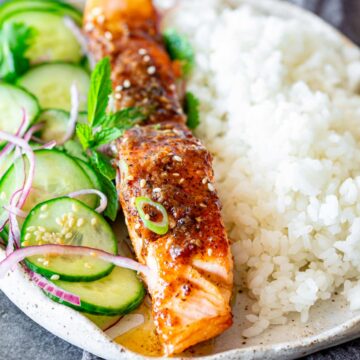
Miso Butter Salmon
This Miso Butter Salmon is one of those recipes that feels fancy but is actually super easy to make! The fillets are pan-seared, giving them that crispy, golden crust. But the real magic happens when you add the miso butter – it melts over the salmon, creating a rich, umami-packed sauce that takes this dish to the next level. Serve this with some rice or a fresh side of greens or salad, and you've got a meal that's easy enough for a weeknight but impressive enough to serve to guests.
Ingredients
For the miso butter
- ¼ cup white miso (see note1)
- ¼ cup butter softened (see note 2)
- 1 tablespoon brown sugar
For the salmon
- 4 salmon fillets skinned
- 1 tablespoon olive oil
- 1 teaspoon sesame seeds
- 1 tablespoon green onion sliced
Instructions
- Ensure the butter is very soft (see note 2), and then add the miso and brown sugar. Mix well until thoroughly combined. Set to one side.¼ cup butter¼ cup white miso1 tablespoon brown sugar
- Place a large nonstick frying pan or skillet over medium-high heat and add the oil.1 tablespoon olive oil
- Add salmon to the pan, presentation side down. Sear for 3 minutes, then flip and cook for 2 minutes on the underside. (see note 3&4)4 salmon fillets
- After 2 minutes, spoon the miso butter over the top of the salmon and allow to melt for a minute.
- Sprinkle the salmon with the sesame seeds and chopped green onion.1 teaspoon sesame seeds1 tablespoon green onion
- Serve immediately.
Notes
- Although I have specified white miso in the recipe, yellow miso would also work. If all you have available is red miso, reduce the quantity to 2 tablespoons rather than ¼ cup. Don't use Saikyo Miso as it is too sweet for the dish.
- I rarely have unsalted butter in the house, so I use salted butter. You can use either. You want the butter to be very soft before combining the miso and sugar into it. You should be able to push your finger into it with no resistance. If yours is a little hard, cut it into small chunks, as it will soften quicker. You can also microwave it for a few seconds, but take care not to melt it.
- The recipe cooks the salmon for around 6 minutes, giving you a soft, just-cooked interior. If you prefer a firmer cook on your fish, cook it for 4 minutes on each side.
- When cooking the salmon, place it presentation side up into the frying pan. By this, I mean that the top of the salmon is in the pan, and the underneath (the side where the skin was) faces up. Doing this gives you a great crust on the top of the salmon and helps the salmon keep its shape.
Tried this recipe?Let us know how it was!
Nutrition
Calories: 425kcal | Carbohydrates: 8g | Protein: 36g | Fat: 27g | Saturated Fat: 10g | Polyunsaturated Fat: 6g | Monounsaturated Fat: 9g | Trans Fat: 0.5g | Cholesterol: 124mg | Sodium: 819mg | Potassium: 884mg | Fiber: 1g | Sugar: 4g | Vitamin A: 458IU | Vitamin C: 0.3mg | Calcium: 42mg | Iron: 2mg
Nutrition is per serving
For more great recipes follow me on PinterestFollow @sprinklessprout